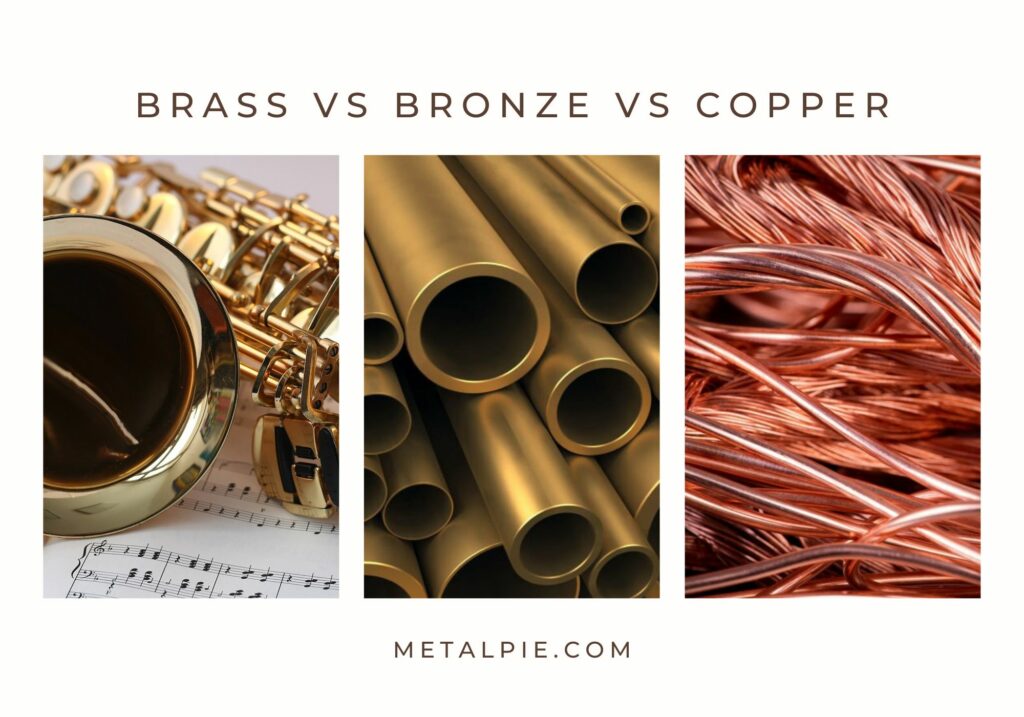Metals are prevalent all around us. We need them in every place we go. From households to large industries, from automotive vehicles to large marine ships, we need metals. We can’t even live without them. We need electricity, and copper & brass play a crucial role here. Besides, our vehicles, boats, and currencies use bronze, aluminum, and steel. Our infrastructure requires robust metal parts & pipes. So, the importance of metals can not be overstated. However, today, our primary focus is brass vs bronze vs copper.
We will mainly talk about these three metals’ distinct properties, grades, and applications. We will also talk about some factors in choosing the right material for your project. So, let’s explore more.
Introducing Copper Materials
Copper material is one of the most widely used naturally occurring metals. Right after ferrous or Iron, it is Earth’s most renowned transition metal. We can find this element in the 4th period on the periodic table. Copper is a prevalent material for its excellent electrical conductivity. It is ductile, which provides excellent machinability.
Copper comes in various grades. The most common grades are Alloy 101, 110, 122 and 145. Alloy 101 provides excellent ductility & conductivity. On the other hand, alloy 110 provides exceptional formability and ductility. However, alloy 122 has improved weldability, while 145 offers enhanced electrical & thermal conductivity.

Copper Application
Copper (Cu) is a versatile metal that finds applications in various industries. Its unique conductivity, malleability, and corrosion resistance make it popular in these sectors.
You know, copper is an excellent conductor of electricity. Therefore, we often find them in electrical wiring, power distribution, and electronic equipment. The technical fact here is that copper offers low resistance to current flow. As a result, they are ideal for manufacturing wires that efficiently transmit electrical energy.
Moreover, we can find other copper applications as well. Copper tubes, pipes, and fittings can be found in plumbing, fire sprinklers, and many more applications. However, in automotive, fuel gas, industrial, and marine, the application of copper is extensive.-
Introducing Brass Material
Brass is an alloy of copper and zinc. The combination of these two materials makes this alloy suitable for various applications. Usually, most modern brass material is composed of 67% of copper and 33% of zinc. This may range from 55% to 95% of copper and 5% to 45% of zinc. They provide excellent hardness and machinability.
Brass material also comes in various grades. The popular grades are Alloy 260, 272, 330, 353, 360, 385 and 464. Brass alloy 260 is used in ammunition and hardware. On the other hand, brass alloy 272 provides excellent weldability. Other grades also provide unique advantages that make them suitable for various industries.

Brass Application
Brass material is prevalent in many industries because of its two benefits. It is excellent in applications where low friction and corrosion resistance is a concern. Notable goods include locks, hinges, gears, bearings, bullet casings, and zippers. Brass is also used in various musical instruments such as trumpet, horn, tuba, and many more.
Introducing Bronze Material
Bronze is also an alloy metal, mostly made of copper and tin. It may also include other materials depending on various requirements. Aluminum, silicon, manganese, and phosphorus are among the other elements. Bronze material provides excellent ductility, hardness & brittleness. Because of their high melting point, they are prevalent in high-temperature applications.
Alloy 932 and 954 are the two most popular grades of bronze material. Alloy 932 is a famous tin bronze. It is preferred for its excellent castability and corrosion resistance. On the other hand, alloy 954 is a famous aluminum bronze. These alloys are commonly available in flat bars, hollow, and solid rods. Other alloys include nickel, aluminum bronze, manganese bronze, bearing bronze, and others.

Bronze Application
Bronze and its alloys are widely used in many applications worldwide. Popular applications can be found in the construction, electric, machinery, and sports industries. Besides, bronze is used in industrial castings to make pumps, valves, and various automotive parts. Marine architecture, such as hulls, pumps, and engine parts, also requires bronze materials.
Bronze alloys such as aluminum bronze (alloy 954) are commonly used to produce pumps, valves, and other hardware. Copper-tin bronze alloys are widely used to manufacture musical instruments such as bells and cymbals. Nickel-aluminum-bronze alloys offer exceptional corrosion resistance and high strength. Therefore, they are employed in the oil & gas industry.
Difference between bronze, bronze, and copper
We have already learned the fundamentals of copper, bronze, and brass. You now know that these three metals are crucial in many industries worldwide. This section will specifically focus on their distinct properties and material composition. We will distinguish their differences and learn more about their suitability.
Brass vs Bronze vs Copper: Element Composition
Brass, bronze, and copper are distinct alloys with different compositions and properties. Each material has its unique characteristics. Their applications are also influenced by their compositions and resulting properties. We will talk about the properties in the following section.
Copper is a pure element, represented by the chemical symbol Cu. On the other hand, brass is an alloy of copper and zinc. Typically, the compositions of brass include high-zinc and low-zinc brass. In high zinc brass, the zinc content may present 30% more. Conversely, the zinc content may present 20% or less in low-zinc brass. Bronze is an alloy of copper, usually with tin as the main alloying element. The percentage of tn or other alloying elements can vary. Note that different alloys are designed for specific purposes.
| Copper | Bronze | Brass |
| Pure element | An alloy of copper & zinc | An alloy of copper and mostly tin |
Brass vs Bronze vs Copper: Varying Properties
Brass, bronze, and copper are distinct materials with varying properties. Their differences are mainly in their compositions and the alloying elements. We can evaluate their physical properties and mechanical properties.
Physical Properties
Physical attributes are a material’s behavior that may be measured without changing composition.
Copper, brass, and bronze exhibit varying physical properties. Copper has a reddish-brown color. On the other hand, bronze & brass vary in color based on their alloy composition. Their densities, melting points, and thermal & electrical conductivity also differ.
| Properties | Copper (Cu) | Brass | Bronze |
| Electrical conductivity (S/m) | 5.96 x 107 | 1.6 x 107 (26-28% of Cu) | 0.89 x 107 (15% of Cu) |
| Thermal conductivity (BTU/hr-ft²-°F) | 229 – 1440 | 223 | 64 |
| Density (kg / m3) | 8906 | 8553 | 7702 |
| Melting point | 1084°C (1,984°F) | 930°C (1710°F) | 913 (1675°F) |
| Corrosion resistance | Excellent | Good | Excellent |
Mechanical Properties
Mechanical characteristics define how a material behaves when subjected to applied forces. In this case, copper, brass, and bronze have distinct mechanical properties. Copper offers moderate strength and high flexibility. On the other hand, brass offers excellent strength & malleability. And bronze offers increased hardness. Their varying tensile, yield, shear, hardness, ductility, and brittleness influence their applications.
| Properties | Copper (Cu) | Brass | Bronze |
| Tensile strength | 210 MPa | 300-500 MPa | 68 – 800 MPa |
| Yield strength | 33 MPa | 124 – 310 MPa | 68 – 800 MPa |
| Shear strength | 172 MPa | 270 MPa | 44 – 537 MPa |
| Hardness | 89 MPa | 37 – 155 MPa | 40 – 420 MPa |
| Ductility | Excellent | Good | Good |
| Brittleness | Low | Low | Low to medium |
Brass vs Bronze vs Copper: Cost
Costs of brass, bronze, and copper vary based on alloy compositions and production processes. Copper is often more affordable due to its elemental purity. On the other hand, brass and bronze may have higher production costs. Compared to bronze, brass is often more economical due to its zinc content.
How to Choose the right material for your project
Selecting a suitable metal for a project requires considering various factors. Material properties, project requirements, and environmental conditions are the prime concerns. Considering all these factors, you can make an informed decision while choosing the right metal. Indeed, an appropriate choice ensures optimal performance & cost-effectiveness.
- First, define the specific needs of your project. You can consider the strength, conductivity, corrosion resistance requirements, and other factors.
- Understand the physical and mechanical properties of metals. Consider factors like hardness, ductility, and thermal conductivity in this case.
- Evaluate the exposure type of your project. Consider the factors like temperature, humidity, and corrosive agents.
- For alloys like brass & bronze, evaluate the composition to meet specific requirements.
- Check for their ease of machinability and weldability on the project’s manufacturing processes.
- Consider the costs, processing expenses, and long-term maintenance. In addition, try to balance between performance & budget constraints to find a suitable choice.
- Finally, you can seek assistance from material experts or engineers to make informed decisions.
Summary
Let’s wrap everything up! Copper, brass, and bronze are major metal elements in many industries. They have distinct properties suitable for a wide range of applications. Copper, a pure element, provides exceptional electrical & thermal conductivity, corrosion resistance, and malleability. Brass, an alloy of copper & zinc, offers enhanced corrosion resistance and a gold-like appearance. Finally, bronze, an alloy of copper & tin, offers increased hardness & ductility.
These metals find applications applications in many industries. Electrical wiring and plumbing applications require copper material. On the other hand, brass is used to make musical instruments and decorative items. Bronze is prevalent in sculpture and bearings productions. Each alloy’s unique properties cater to specific needs.
